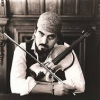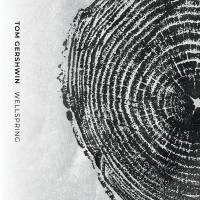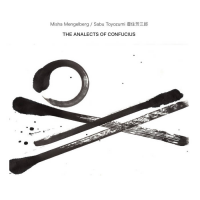Home » Jazz Articles » Extended Analysis » Eberhard Weber: Eberhard Weber: Hommage à Eberhard Weber
Eberhard Weber: Eberhard Weber: Hommage à Eberhard Weber
But even as Weber's career seems to be winding down—whether or not there will be more albums made like Resumé and Encore remains to be seen—his importance and influence continues to be felt. In 2007, the year of Weber's stroke that's recounted in detail in an extensive 2013 All About Jazz interview, Weber released Stages of a Long Journey, culled from a 65th birthday celebration concert in Stuttgart, Germany, where a career-spanning set of Weber compositions were orchestrated for the SWR Radio Symphony Orchestra Stuttgart, with guests including, along with Garbarek, vibraphonist Gary Burton, pianist Rainer Bruninghaus, percussionist Marilyn Mazur...even, on one track, pianist Wolfgang Dauner (who employed Weber on his own albums and in the United Jazz + Rock Ensemble).
But that was the last time Weber would appear, playing bass, on a recording of his own in real time, as just three months prior to Last Stage's release Weber suffered the stroke that has forever changed his life. But it's now 10 years since that 65th birthday concert, and to celebrate not just Weber's music but the thankful fact that he remains here with us, Hommage à Eberhard Weber may not include Weber performing in real time but the bassist's writing and playing remain a key component of the two evenings from which the album has been culled, thanks to technology—and, for nearly half of the CD's 70-minute runtime, the return to ECM of an artist who knows, perhaps, more than most when it comes to harnessing that technology in the pursuit of seamlessly organic music-making.
Guitarist Pat Metheny is back for the first time since the 1974 to 1984 run that kickstarted his career, first as a member of Gary Burton's group but ultimately as the influential solo artist into which he has continued to evolve across the past four decades, ending his relationship with the label in that final year with two releases: Pat Metheny Group's Grammy Award-winning First Circle and Rejoicing, the guitarist's renowned trio date with Charlie Haden and Billy Higgins.
Weber is not just all over this record in the various compositions that have been drawn from nearly his entire career, arranged for a series of guests and the SWR Big Band, but he is actually heard—and, for those fortunate enough to have been there, seen—performing in the form of archival video recordings played on a large screen hung above the stage: video samples, then, rather than merely audio samples.
But the video footage of Weber playing is not just used as a tribute device; it's actually used as one of the fundamental anchors to "Hommage," Metheny's 32-minute composition in honor of Weber. The guitarist delivers a potent suite based on a number of Weber compositions and improvisations, ranging from "Seven Movements," first heard on 1988's bass and brass ensemble recording Orchestra, to "Street Scenes," from Weber's solo bass (with loops) recital, Pendulum (1993).
What is most remarkable about Metheny's half-hour tour-de-force is how, having evolved into a vastly influential voice of his own, the guitarist somehow manages to blend the very things that define Weber into his own musical continuum, creating a seamless whole where both make perfect sense together. Metheny's writing for the big band is also a revelation, if only because it's something he's not done before, at least on record. And while there are plenty of musicians who have used audio samples since the 1980s, few have done what Metheny has, which is to use Weber's video samples, so that Metheny and his band are actually playing with Weber...a particularly powerful moment coming when bassist Scott Colley is actually duetting with Hommage's titular subject.
It's not so far-fetched to find the bass pattern at the heart of "Seven Movements" acting as the anchor to both a richly detailed initial foray for the brass/woodwind-heavy SWR Big Band and Burton's lengthy vibraphone solo; but how Metheny later transforms "Street Scenes" into one of the guitarist's longstanding cornerstones—music redolent of his birthplace in the American Midwest, with its strummed guitar and cymbal-heavy support of drummer Danny Gottlieb—is pure magic. And that's only two segments of a long-form composition where Metheny, as always, finds a way to incorporate a variety of his signature guitars sounds, ranging from the warm hollow body electric that layers the suite's early theme to the trumpet-like Roland guitar synth, first introduced on 1982's Offramp, on which he solos midway through "Hommage," building to an early climax of soaring synth, thundering drums and dynamically/dramatically ascending horns, only to dissolve into a new passage driven by yet another of Weber's improvisations, this time with the horns acting as accents, counterpoints and unison partners.
But beyond the marvelous soloing from Metheny, Burton and Gottlieb—who contributes a frenetic show-stopper of a solo in the closing third of "Hommage"—the suite also demonstrates Metheny's ear for broader harmony, melodic interaction and sonic color. These three musical characteristics have been constant companions with which he has experimented over the years through the use of technology: first, in the 1980s with the advent of the Synclavier, an early digital synthesizer and polyphonic sampling system; and, more recently, with his own solenoid and pneumatic-driven Orchestrion, where Metheny has been able to bring a different kind of MIDI-driven analog orchestra on the road—either solo, as documented on The Orchestrion Project (Nonesuch, 2013), or with groups ranging from his trio with Larry Grenadier and Bill Stewart to the Unity Group that released the studio recording Kin (<—>) (Nonesuch, 2014) and the about-to-be-issued The Unity Sessions (Eagle Rock, 2015) concert video.
But here, with real instruments and real players, Metheny has the opportunity to work with everything from the ethereal sound of flutes and the darker burnish of trombones and euphonium to the brasher attack of trumpets and saxophones. There is, it seems, no limit to what Metheny can do, depending on the toolkit he's given...in this case, a conventionally configured big band augmented by Gottlieb, Burton and Colley (whose history with the guitarist goes back more than a decade, including Metheny's "By Invitation" series of concerts at the 2005 Festival International de Jazz de Montréal).
Metheny's history with Weber, despite not being a particularly current one until the commissioning of this piece, goes right back to the beginning of the guitarist's career. RecruitIng Weber to play on his second ECM album as a leader, 1977's Watercolors, Metheny had already spent significant time in the studio and on the road with the bassist as a member of Gary Burton's band. Metheny first appeared on Ring (1974), the fourth of the vibraphonist's ten albums as a leader for the label from 1973 through 1986, reprising their collaboration again three years later on Burton's Passengers, released the same year as Watercolors (but this time as sole guitarist with the departure of Ring's Mick Goodrick) and also featuring Gottlieb, who went on to become the first drummer in Metheny's flagship Pat Metheny Group—and who, like Metheny, makes a triumphant return to the label here, in the drummer's case, for the first time since PMG's 1983 double live album Travels, another Grammy winner and perennial fan favorite.
Still, across the years Metheny has consistently cited Weber as a seminal influence on his own evolution as a writer, something that can clearly be heard from the orchestral ending of the more techno-driven "The Roots of Coincidence" on Imaginary Day (Warner Bros., 1997) to the sweeping ambitions of PMG's so-far swan song, the continuous 70-minute composition The Way Up (Nonesuch, 2005).
But as much as "Hommage" cannot help but be the centrepiece of Hommage à Eberhard Weber, there's plenty more music and magic to be found across the CD's remaining 40 minutes—or, for those who buy either high resolution or Mastered for iTunes downloads, 50 minutes, as the digital edition of the album also includes a nine-minute bonus track, "Street Scenes," which, while also used to drive Metheny's Midwestern-tinged segment of "Hommage," is this time arranged by Libor Suma. Featuring extraordinary solos from both the ever-perfect Burton and equally impeccable Paul McCandless—the reed/woodwind multi-instrumentalist from Oregon who was also a longtime Weber collaborator—in Suma's hands Weber's solo bass piece becomes something else entirely, as the horns both mirror and swirl bright harmonies around Weber's ever-melodic bass line, demonstrating just how different the same musical kernel can be as inspiration in the hands of two very different composer/arrangers.
Elsewhere, arrangers take existing Weber material and mould it into something new but still unmistakably Weber. "Touch," the five-minute opening track to 1976's Yellow Fields (the first of three recordings with the bassist's Colours group collected on the Old & New Masters Edition box set, Colours, in 2010) may begin immediately with drummer Jon Christensen's loose but unshakable pulse, but Ralf Schmidt's lengthier reading opens more decidedly in the clouds, with Burton's vibraphone and SWR member Ernst Hutter's euphonium anchored by a paradoxical atmospheric yet grounded horn pedal tone that only gradually gives way to the emergence of the familiar pulse and melody that defines the tune. Guest conductor Michael Gibbs' arrangement of "Maurizius," from one of Weber's best albums, 1982's Later That Evening, seems somehow more faithful—even though, with the exception of McCandless, who takes an extended soprano saxophone solo, is the only instrument, along with bass and drums, that is common to both versions. Instead, Burton assumes the role of the original version's pianist, Lyle Mays, while Gibbs uses the broader colors of the big band to expand upon Weber's writing, adding more pulse and, at times, staccato punch to the largely atmospheric composition.
Hommage à Eberhard Weber also focuses on Weber's recent approach to composition and music-making. The set opens with Resumé Variations, with Jan Garbarek's dryly piercing and ever-soaring curved soprano creating a fanfare for the evening that, while based on tracks from Weber's 2013 recording, is considerably longer than any of the album's dozen compositions, as it continues to assert the saxophonist's lifelong pursuit of tonal purity.
Perhaps the most surprising interpretation of any of Weber's pieces, however (beyond Metheny's set-defining "Hommage"), is the CD-closing (and, at the two-night performance, set-closer as well) "Notes After an Evening," based on a loop-driven bass solo from Pendulum. The shortest track of the set at five-and-a-half minutes, it's a heartfelt example of Weber's ability to draw honest lyricism from the ether. There may be relatively little to work with in this two-chord piece, but the arrangement (one of five tracks conducted by Norway's Helge Sunde), makes beautiful use of the big band to create a lullaby-like conclusion that, driven gently by the big band's drummer, provides short but sweet solo segments for Burton, McCandless (this time on oboe) and SWR alto saxophonist Klaus Graf. it's a lovely closer to what must have been two wonderful evenings—for the musicians, for the audience...and for Weber.
After all, how often do musicians receive this kind of treatment while they're still with us? What the future holds for Weber as he starts the path towards octogenarian status is uncertain; but were he to issue not a single note more, his legacy would already be well-assured, based on the fourteen albums he has released under his own name, the nine albums made with Garbarek along with a quarter century of touring with the saxophonist; and guest appearance on albums by artists ranging from Ralph Towner, Pat Metheny, Wolfgang Dauner and the United Jazz + Rock Ensemble to Joe Pass, Stephane Grappelli, Manfred Schoof and Kate Bush. Unlike so many other musicians, however, whose instrument(s) can be separated from their compositions, Weber has always seen the two as inextricably linked.
"I analyzed my compositions, and I realized that whenever I wrote, it was always together with my bass," said Weber in his 2013 All About Jazz interview. "In other words, the sound of my bass is always very important. So suddenly, I realized I can't play bass anymore, and to be just a composer or an arranger, I really couldn't compete with all these young guys, who are so capable of doing everything. I realized I needed my bass, and so the question then was what to do."
That Weber has managed to create two albums worth of compositions based on improvisations culled from decades of touring is a remarkable feat in and of itself. Whether he can continue to find suitable grist is yet to be determined, but in the meantime, Hommage à Eberhard Weber honors Weber in a way that both appreciates and respects that inextricable link, and couldn't be a more perfect tribute—or a more perfect gift—to this uniquely talented and influential bassist/composer.
Track Listing
Resumé Variations; Hommage; Touch; Maurizius; Tübingen; Notes After an Evening; Street Scenes (bonus track, HD and Made for iTunes only).
Personnel
Eberhard Weber
bassPaul McCandless
woodwindsPat Metheny
guitarJan Garbarek
saxophoneGary Burton
vibraphoneScott Colley
bassDanny Gottlieb
drumsHelge Sunde
tromboneMichael Gibbs
tromboneSWR Big Band
band / ensemble / orchestraPat Metheny: guitars (2); Jan Garbarek: soprano saxophone (1); Gary Burton: vibraphone (2-7); Paul McCandless: oboe and soprano saxophone (4-7); Scott Colley: double bass (2); Danny Gottlieb: drums (2); SWR Big Band (2-7); Helge Sunde: conductor (2, 3, 5-7); Mike Gibbs: conductor (4).
Album information
Title: Eberhard Weber: Hommage à Eberhard Weber | Year Released: 2015 | Record Label: ECM Records
Tags
PREVIOUS / NEXT
Support All About Jazz
 All About Jazz has been a pillar of jazz since 1995, championing it as an art form and, more importantly, supporting the musicians who make it. Our enduring commitment has made "AAJ" one of the most culturally important websites of its kind, read by hundreds of thousands of fans, musicians and industry figures every month.
All About Jazz has been a pillar of jazz since 1995, championing it as an art form and, more importantly, supporting the musicians who make it. Our enduring commitment has made "AAJ" one of the most culturally important websites of its kind, read by hundreds of thousands of fans, musicians and industry figures every month.


























